Artificial intelligence (AI) represents a significant shift, promising to transform operations and drive innovation across industries. With the AI software market projected to hit $2 trillion by 2030 and more than half of businesses already integrating AI into their operations, the excitement around AI's potential is palpable. Yet, it poses challenges for many entrepreneurs.
As an experienced agency in the domain of Artificial Intelligence, we stand ready to guide you through these challenges. While over 76% of enterprises planned to increase their AI investments in 2023, we understand the challenges of adopting and scaling this technology.
Let us be your ally in creating AI software to unlock its power with confidence and precision.
What is AI software?
AI software refers to apps, websites, or programs that are powered by artificial intelligence to perform tasks that usually require human intelligence. These applications can range from chatbots that help answer your questions and recommendation systems on shopping sites that suggest products you may like, to more complex programs that can analyze large sets of data to find patterns.
Unlike traditional software that follows a strict set of rules, AI applications learn from the data they process, allowing them to improve over time and make decisions or provide insights that weren't explicitly programmed into them. For example, this is the case with AI chatbots.
Essentially, such software is a tool designed to think, learn, and adapt, making it incredibly versatile and valuable in solving a wide variety of problems.
What can you do with AI?
AI's capabilities extend through computer vision, natural language processing (NLP), audio processing, and reinforcement learning, each offering unique applications and improvements.
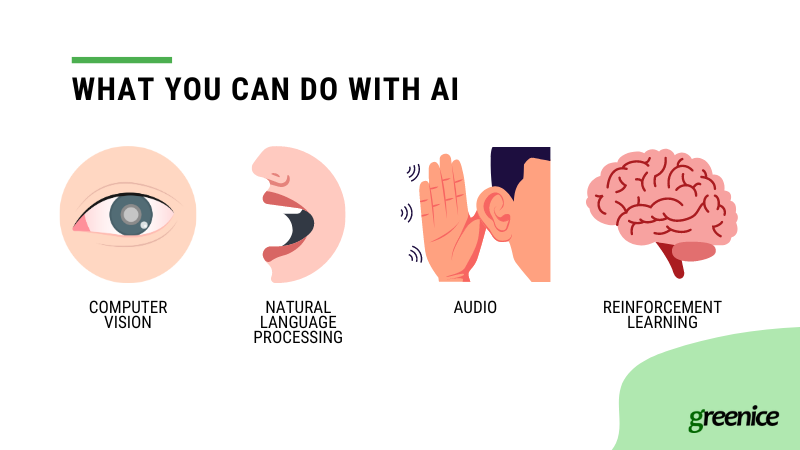
Computer Vision techniques enable AI to interpret and understand visual information, facilitating tasks like depth estimation, image classification, segmentation, and conversion between text and images or videos. This allows for innovative applications such as autonomous vehicles, facial recognition systems, and advanced content creation tools.
Natural Language Processing (NLP) empowers Artificial Intelligence to process and comprehend human language, making it possible to perform text classification, generation, translation, summarization, and question-answering. NLP technology enhances user interactions with machines, improves content accessibility, and streamlines information retrieval and analysis.
In the Audio domain, it contributes to text-to-speech conversion, audio-to-audio transformation, audio classification, and speech recognition. These capabilities enable more natural user interfaces, accessibility features, and efficient processing of audio data for various applications, including virtual assistants and automated transcription services.
Reinforcement Learning offers a framework for AI systems to learn optimal actions through trial and error, improving over time based on feedback from their environment. This approach is particularly useful in game development, robotics, and for optimizing decision-making processes in complex systems due to the multi-modal abilities of the models allowing them to perform different types of tasks at the same time.
As the technology continues to evolve, its capacity to augment and automate tasks will only expand, opening new horizons for innovation and improvement in countless applications.
Benefits of using AI in various industries with examples
Artificial Intelligence software is changing industries by enhancing efficiency, accuracy, and personalization. Here's how it is being implemented across various sectors, followed by real-world examples of companies and software that have successfully integrated this technology:
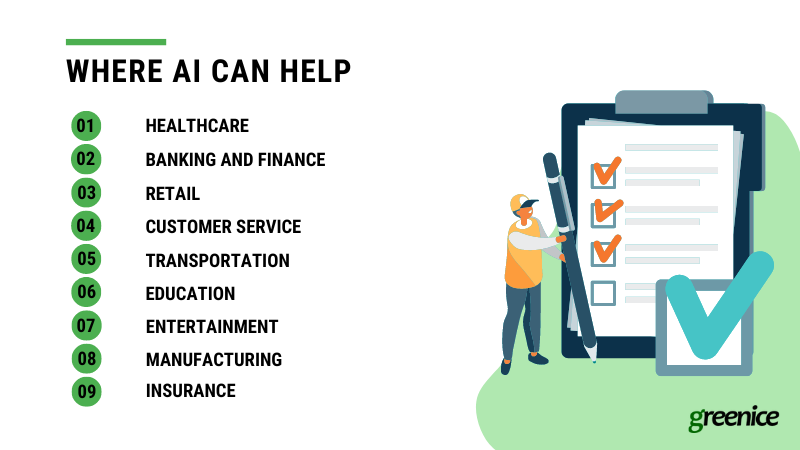
- Healthcare: improves diagnosis accuracy, patient treatment, and early detection of diseases. For instance, DeepMind Health by Google's DeepMind has developed a tool that assists doctors in diagnosing eye diseases and breast cancer more quickly and accurately, significantly improving patient outcomes.
- Banking and finance: streamlines client onboarding, enhances security, and detects fraud; it also boosts loan origination volumes and improves debt collection efficiency in finances. KAI, developed by Kasisto, is a conversational AI platform that creates personalized and engaging customer experiences for banks and financial institutions, streamlining financial tasks and queries with high accuracy.
- Retail: demand forecasting, price optimization, and improved product placement. IBM Watson Commerce uses AI to personalize online shopping experiences, analyzing customer data to provide tailored recommendations that improve engagement and boost sales.
- Customer service: AI-powered chatbots in customer service offer immediate assistance and reduce wait times. The Greenice Virtual Assistant, for example, integrates with our website to answer common customer questions and provide primary consultation on our services, improving efficiency and customer satisfaction.
- Transportation: enhances road safety and vehicle automation in the transportation industry. Tesla Autopilot is a leading example, where Artificial Intelligence enables vehicles to autonomously steer, accelerate, and brake, showcasing the potential in making driving safer and more convenient.
- Education: tailors learning experiences to individual needs, making education more accessible. Duolingo uses this technology to personalize language lessons based on the learner's pace and style, improving the efficiency and effectiveness of language acquisition.
- Entertainment: boosts content discovery in entertainment, tailoring recommendations to user preferences. Netflix employs an AI Recommendation Engine to analyze viewing patterns, significantly enhancing content discovery and user satisfaction by recommending movies and TV shows that match individual tastes.
- Manufacturing: optimizes processes and reduces downtime. Siemens MindSphere, an open IoT operating system, uses AI to analyze data from connected devices, streamlining manufacturing processes and predictive maintenance, leading to increased efficiency and reduced operational costs.
- Insurance: streamlines claims processing and detects fraud in the insurance industry. Such applications can quickly verify claim-relevant data and alert on fraudulent activity, streamlining the evaluation process and ensuring accurate loss estimation.
Finding your AI strategy
When considering developing AI software, there are three main options available, each with its advantages and use cases. Understanding these can help you choose the most suitable path for your project:
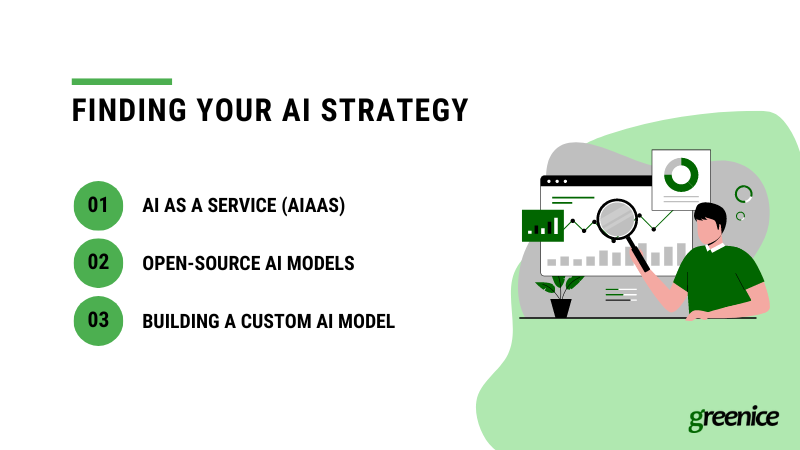
AI as a Service (AIaaS)
Artificial Intelligence as a Service refers to cloud-based, third-party services that provide pre-trained or customizable artificial intelligence solutions. Businesses and individuals can access these capabilities via the API without needing to build their own complex infrastructure. The most famous example is OpenAI and its GPT and Dall-E models, but today there are many other options, including IBM’s Watson and Google’s Gemini. All users have to do is select appropriate AIaaS providers, and integrate these services into their applications.
The main investment is a subscription to the model provider. The user pays to access the model through the API while its provider covers all the related services like hosting the model. This choice is for businesses needing standard functionalities with minimal customization.
This option is the most accessible and affordable, especially for small businesses. Also, keep in mind that this option can be unreliable in terms of security and data privacy. Additionally, with the growth of user number, the price of this option may also increase.
Pros:
- Advanced features - such private models, due to their commercial nature, possess the most advanced functionality.
- User-friendliness - they are easy to use, allowing quick access to AI capabilities without deep technical expertise.
- Rapid deployment - fast implementation of AI features, with cloud-hosted infrastructure and models ready to go.
- Scalability - AIaaS effortlessly scales with demand, offering flexible resource management to adjust to business needs efficiently.
- Initial accessibility - elimination of the need for significant investment in infrastructure and development allows businesses to access cutting-edge capabilities while paying primarily for the services they actually use.
Cons:
- Long-term cost increase - the price for model usage will grow exponentially along with the growth of a number of users.
- Data privacy and security - managing and collecting the data essential for AI while complying with strict regulations like GDPR, HIPAA, and CCPA presents a formidable challenge, balancing privacy concerns with development needs.
- Ethical concerns - LLMs still have issues like racial biases. Training with human feedback reduces overt racial stereotypes but fails to address covert biases, revealing a persistent issue of implicit racial prejudice.
- Explainability and transparency - the opaque nature of many models, especially in deep learning, complicates their understanding and acceptance, posing significant obstacles in regulated fields.
Open-Source AI Models
These solutions are freely available models that can be used by anyone for both personal and commercial needs for free. For example, Hugging Face offers over 500,000 options for any task you can imagine. Choosing this option you take the ‘raw’ model that you will have to train yourself with your data and install it on your physical or cloud server and basically maintain the whole infrastructure yourself (and pay for it).
Open-source models are specialized and perfect for projects needing custom solutions. Though they might not have the wide-ranging abilities of AIaaS offerings from companies like OpenAI or Google, they excel in specific tasks. For those with the skills to modify and enhance these models, open-source options offer a flexible base for developing targeted, high-performance functionalities, making them a preferred choice for niche projects.
Keep in mind that as Artificial Intelligence requires a lot of computational resources - the price for maintenance (whether you’ve chosen the model provider’s services or using another server) can be indeed significant.
Pros:
- High customization - open-source models allow for extensive modification, enabling developers to tailor the technology specifically to their project's needs for optimal performance.
- Cost-effectiveness - since these models are freely available, the main costs come from development efforts rather than licensing fees, making it a more scalable option. This means that with the growth of the user base, the expenses will not increase as much as with the case with AIaaS.
- Community support - open-source projects benefit from the collective knowledge and contributions of a global community, providing a wealth of resources and support.
- Transparency - with open access to the model's code, developers can fully understand and trust how the Artificial Intelligence operates, enhancing both security and reliability.
Cons:
- Hidden threats - though most of the open-source models are mostly secure, you still need to be cautious about possible backdoors left by malefactors.
- Requires expertise - this option requires deep knowledge of machine learning and programming skills for effective adaptation and fine-tuning of models.
- A high amount of resources - they need access to high-performance computing resources for model training, adding to the cost.
- Hidden expenses - additional functionalities, even from the source providing the model, can escalate total costs.
Building a Custom AI Model
This option involves creating tailored solutions from scratch, providing maximum control and a competitive edge. This approach requires in-depth expertise in machine learning and data science, alongside a significant investment in data collection, labeling, and specialized hardware.
Keep in mind that this option requires a considerable level of developer expertise and development time, resulting in significantly higher costs. For example, the cost of ChatGPT for OpenAI was estimated at $544.5 million in 2022 (including expenses on computing and data, staff salaries, and other operations) and it can cost $700,000 a day to run the bot. Not many businesses can make this kind of investment and, therefore, build a model with matching capabilities to the top ones on the market.
However, if you are aiming at something much smaller and unique, custom development can be a good option.
Pros:
- Tailored to your needs - this software is designed specifically for your unique requirements, ensuring that every feature and function directly addresses your business challenges.
- Optimized performance - since the software is customized, it's optimized for efficiency and effectiveness in your specific operational context, leading to superior performance compared to off-the-shelf solutions.
- Competitive advantage - owning a unique, custom-built solution sets you apart from competitors, offering functionalities that no one else has, thereby enhancing your market position.
- Complete control over the code - only your team has access to the code and knows how the software works which increases safety. So the whole system along with your data is under your full control.
Cons:
- Development time - it takes a lot of time, from planning and designing to training the models. This lengthy process can delay the launch of new services or features.
- High cost - it requires significant investment in expert personnel, data processing, and computing resources, making it a costly option compared to open-source solutions or AIaaS.
- Complexity - custom-built AI models come with substantial complexity, requiring expertise to select suitable algorithms, manage data quality and labeling, and ensure seamless integration with existing systems. Additionally, maintaining scalability and high performance adds further challenges, making the development process intricate and resource-intensive.
- Computational resources - the extensive computational power and specialized hardware required for training and deploying sophisticated models can lead to increased costs.
Considering all the challenges of custom-built Artificial Intelligence, Greenice co-founder Sergii Opanasenko says: “With private AIaaS solutions and over 500,000 open source models you barely have a need to create something absolutely new”.
But it is still up to you;)

Choosing the right development approach depends on your customization needs, available technical resources, project timeline, and budget. Whether you opt for the plug-and-play convenience of AIaaS, the flexibility of open-source models, or the tailored precision of custom models, each path offers distinct advantages tailored to different project requirements and goals.
The AI software development life cycle
The development of AI software unfolds through a series of crucial steps, beginning with defining your vision and culminating in launching your innovation into the real world. Let’s look at the development steps for all 3 strategies: AIaaS, open-source models, and building a custom model.
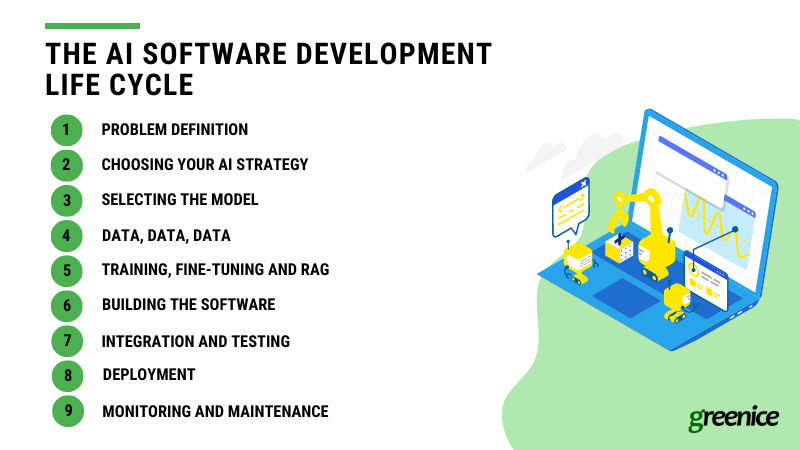
Problem definition
Defining "the problem" in AI development involves pinpointing the exact business issue you aim to solve with AI, which is crucial for aligning the project with business goals and ensuring its success.
Start by analyzing current operations to identify key challenges and tasks that the future software must perform. You can ask some questions like:
- What business challenge or opportunity are we tackling with AI? (E.g., Aiming to enhance customer service efficiency or uncover product development insights.)
- What outcomes are we expecting from AI? (E.g., Operational cost reduction or increased sales through customization.)
For instance, a retail company might define its problem as "reducing cart abandonment rates through personalized customer engagement," guiding the development of the solution like a chatbot for personalized support.
Here are tips for defining the problem:
- Be specific - General problems lead to general solutions. Narrow down the issue to something measurable and concrete.
- Understand the business context - The problem should be significant enough to warrant the investment in the development, with a clear link to business goals.
- Consider data availability - Ensure you have access to the data needed to train the model for your specific problem.
- Look for scalability - The problem should be defined in a way that allows the solution to scale and adapt as your business grows.
This step is vital for whatever technology you are using. Because without a vision and plan you won’t go far.
Choosing your strategy
Choosing the right strategy—AIaaS, open-source, or custom models— is essential for the success of your project. The choice is based on the specific needs of your project and the resources available to you.
Here are some questions to ask to gain some clarity:
- What capabilities are needed for your project? (E.g., What your software should be capable of to solve the problem you’ve defined in the first stage? Does it need NLP or computer vision (or both) to perform its tasks?)
- How quickly do you need to deploy the functionality of Artificial Intelligence? (E.g., Is there a market launch deadline you're aiming for next quarter?)
- What skills and resources do you have for development? (E.g., Does your team possess the necessary expertise, or will you need to hire specialists?)
- How much customization is required? (E.g., Can a standard model meet your needs, or do you require a solution tailored to specific customer interactions?)
- What are the specific requirements of your software? (E.g., Does it need to be HIPAA compliant or fully secure because of the industry?)
If you have answered the questions above, it will be easier for you to pick the most suitable strategy:
- AIaaS for quick deployment with minimal technical effort and when pre-trained models align with your needs.
- Open-source models for projects needing customization with available technical expertise to modify these models.
- Custom development for unique requirements or competitive advantage, requiring more resources but offering full customization.
An informed decision ensures your strategy aligns with your project's goals and capabilities, setting a clear path for successful implementation of Artificial Intelligence.
Selecting the model
In the case of AIaaS and Open-Source options, you will have a variety of models to choose from. But how to understand which one is perfect for your business?
Here are some aspects to think about to select the most appropriate model:
- Problem type - The model needs to align with your task – classification, prediction, generation, etc.
- Data characteristics - Size, quality, format, and labeling of your dataset influence which models are suitable.
- Accuracy requirements - How accurate does the model need to be to meet your goals?
- Performance and latency - How quickly does the model need to deliver results, especially for real-time applications?
- Prototype - For your project, consider developing a prototype that's time and cost-efficient, using different models for comparison. For instance, in our AI-tutor project requiring accurate handwriting and graphics recognition from photos, we created a proof of concept (POC) and tested various OpenAI models. By evaluating their accuracy and token consumption, we determined the most suitable model for our needs.
After this research, it is possible that you will decide to change your strategy so your model would suit your project in terms of interpretability, customization, and cost. As a result, this step will save you from wasting further time and money on building something that doesn’t work.
Data, data, data
Handling data is crucial as it forms the basis for training the models. Data includes various formats like text, images, and sounds, tailored to the AI's specific function. Quality and quantity are key; data must be accurate, relevant, and extensive enough to cover the model's learning needs. The process involves collecting, cleaning to remove errors, and labeling for supervised learning models, which is essential for teaching the Artificial Intelligence the correct outputs.
The effort in data preparation varies by approach. AIaaS often provides pre-trained models, reducing the need for extensive data cleaning and labeling. In contrast, open-source and custom development demand more rigorous data preparation, as these models require customization to specific project needs. Effective data management ensures that your technology can learn accurately, highlighting its importance in the development process.
For instance, if you're developing an app to recognize different types of trees from photos, you'll need a large dataset of tree images. Each image must be accurately labeled with the tree type it represents (such as "oak" or "pine"). This dataset then undergoes cleaning to remove any irrelevant or poorly captured images and labeling to ensure each photo is correctly identified. In an AIaaS scenario, you might access a model already trained on general object recognition, needing fewer images to fine-tune it for tree identification. However, for a custom model, you'll extensively prepare and label a specific dataset to teach the AI precisely how to distinguish between tree species, laying the groundwork for effective learning and accurate predictions.
Training, fine-tuning, and RAG
How do you ensure the model meets specific capabilities and behaviors? Through training, fine-tuning, and Retrieval Augmented Generation (RAG).
Training is the process where the model learns from a dataset to perform its intended task accurately. For example, a model being developed to identify spam emails is trained on a dataset containing examples of both spam and non-spam emails, learning to distinguish between them over time.
Fine-tuning differs from initial training in that it starts with a pre-trained model—usually trained on a vast, general dataset—and adjusts it with a more specific dataset relevant to the particular task. This requires less data and computational power than training a model from scratch because the model has already learned basic patterns. OpenAI calls this process embedding.
Retrieval Augmented Generation (RAG) offers a unique approach beyond traditional training and fine-tuning by merging large language models with external data sources. This allows RAG models to pull in additional, relevant information beyond their training data, ensuring outputs are current and comprehensive. Contrasting with fine-tuning dataset-specific optimization, RAG enhances a model's response generation by accessing and incorporating external information, making it ideal for tasks needing the latest or broad-ranging data.
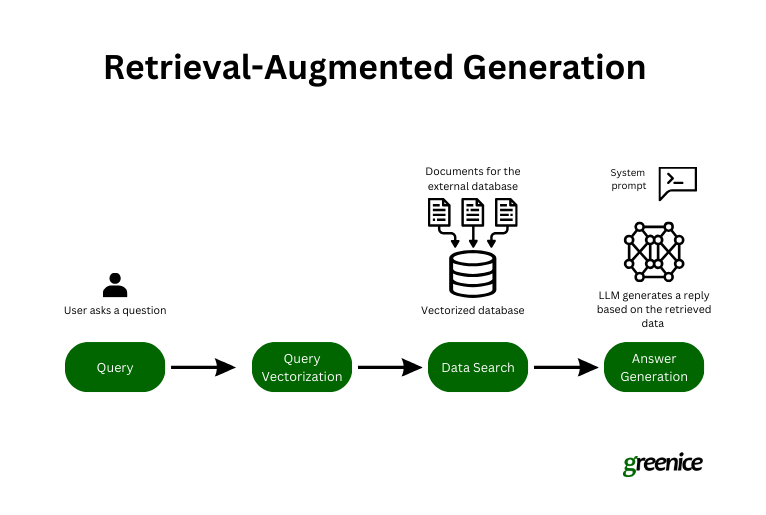
The process of training varies depending on the chosen strategy:
- AIaaS utilizes pre-trained models that need minimal fine-tuning with your data, simplifying the training process.
- Open-source models are also pre-trained but may require more fine-tuning to adapt to your needs.
- Custom-built models involve training a model from zero, tailored to unique requirements, making it the most resource-intensive but offering the highest level of customization.
While AIaaS and open-source models reduce the need for resources by offering a foundation for fine-tuning, custom-built models demand more extensive training but provide unparalleled specificity to business needs.
Building the software
Once your strategy is set and the models are chosen, developing the software that houses the AI involves several detailed steps:
1. Architecture design
In this step, you focus on integrating the model with your software's broader system. This involves defining API calls for seamless communication between your software's front and back ends and the model, ensuring data can be sent to and received from the AI efficiently. You must also decide between real-time processing, which offers instant AI predictions, and batch processing, where data is accumulated and analyzed periodically. Additionally, mapping out the data flow is crucial, outlining how data will enter the model, be processed, and then how the results will be re-integrated into your application to complete the cycle.
2. Front-end development
The development of the user interface (UI) focuses on creating intuitive and accessible ways for users to interact with the AI. This includes designing data input mechanisms, like forms or file upload options, that allow users to easily provide information to the model. Moreover, planning how to display the AI-generated results—whether as text, images, or recommendations—is essential for ensuring that users can understand and act upon these insights effectively.
3. Back-end development
Handling data is a significant aspect of back-end development, encompassing preprocessing steps to clean or format data suitably for the model and postprocessing to adapt the AI's output for application use. Developing robust API endpoints is also key to facilitating efficient communication between the front-end UI and the model. Furthermore, deploying the model in a way that it's accessible to your application, such as through containerization or as a web service, is vital for operational integration.
Integration and testing
Thorough testing of the entire system is imperative. End-to-end testing ensures that from the moment user input is received, through the AI processing, to the output presentation, every component works seamlessly together. Performance testing helps assess the system's handling of expected workloads and data processing volumes, ensuring reliability under pressure. Gathering user feedback is also crucial for validating that the AI integration meets user expectations and adds tangible value to the application.
Deployment (Launch)
This final step involves rolling out the fully developed and tested software to users, ensuring it performs as expected in live environments. It's a critical phase where the software becomes accessible to its intended audience, requiring careful planning to manage deployment logistics, user onboarding, and initial support to address any immediate feedback or issues. A successful launch is important for delivering the software's AI-driven solutions to end users, marking the transition from development to real-world application.
Monitoring and maintenance
The monitoring and maintenance phase is critical in development, highlighting that models require ongoing oversight to stay effective. This stage involves tracking the model's performance and making necessary adjustments in response to new data and changing conditions. Developers use tools like Cloud Monitoring by Google and TensorBoard by TensorFlow for this purpose, which help identify and rectify performance issues or inefficiencies.
For open-source models, the community offers invaluable support, providing updates, fixes, and best practices. In contrast, AIaaS models are maintained by providers, reducing the workload for users. However, custom AI software demands a more hands-on approach from the development team for continuous updates and problem-solving.
In essence, whether leveraging community resources for open-source models, relying on service providers for AIaaS, or depending on internal teams for custom solutions, proactive monitoring and maintenance ensures the longevity and relevance of your project.
Each of these steps is vital to the development process, forming a comprehensive approach that guides the project from an initial idea to a fully integrated solution.
Looking for a team to build an AI software?
How much does it cost to build AI software?
Building AI software encompasses various cost factors across development, user experience, data management, infrastructure, and the models themselves.
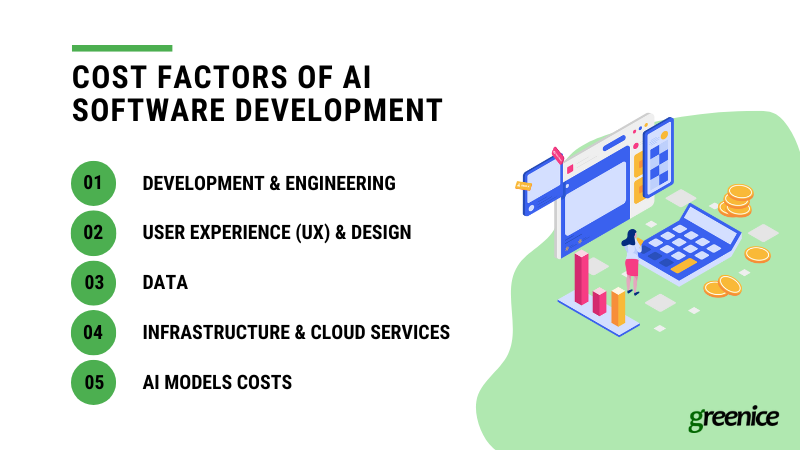
1. Development & engineering
Costs here include salaries or fees for software developers, who build and integrate the AI model and user interface. Project management involves costs for planning and coordination, while DevOps or IT support covers setting up environments, deployment, and maintenance.
The developer’s rates are ranging from $20-$40 per hour in regions like Asia and Africa to $90-$150 in North America. Opting for the lowest cost can often lead to longer development times, quality issues, and potential overhauls. Developers from Eastern Europe will charge you $30-50 per hour for a decent-quality job.
2. User experience (UX) & design
UI/UX designers are tasked with making AI features user-friendly and visually appealing, supplemented by user research like testing or interviews to ensure usability and product-market fit. On average, UX designer rates are $25-39 per hour.
3. Data
There are expenses for acquiring, licensing or collecting the necessary data. If supervised learning is used, data labeling and annotation can add significant costs for human labor or tools. Additionally, data storage requires database or cloud services for dataset management.
4. Infrastructure & cloud services
Computational resources for running models and other tasks require investment in servers or cloud instances, with additional costs for networking and managed services like cloud databases and monitoring tools.
AIaaS models are hosted by a provider, so the client only needs to host their app. In the case of open-source and custom models, the client is responsible for hosting both the model and the app. Additionally, the stage of training or fine-tuning the model needs the most computational resources and can significantly exceed the costs for the creation of the model or even its further utilization. To illustrate this, training the biggest AI models might soon cost up to $1 billion, says James Hamilton from Amazon's AWS. He shared this in a presentation, noting that AWS spent $65 million on a big project last year. But with newer technology, costs could jump ten times higher for future models.
5. AI models costs
Costs vary based on the strategy and the model. Let’s look at the most famous examples:
Amazon Lex's AIaaS model offers a free tier for new users with up to 10,000 text and 5,000 speech requests per month for the first year, then charges from $0.004 per text and $0.0065 per speech request.
GPT models use a token-based pricing system, starting at $0.0005 per 1k input tokens and $0.0015 per 1k output tokens, increasing with model complexity.
Open-source models, while free, require investment in development and computational resources, with customization potentially introducing hidden costs. Hugging Face provides infrastructure for these models, with upgrades for better performance or additional storage starting at $5 for small persistent storage and dedicated Inference Endpoints at $0.06/hour.
In the case of custom models, the costs depend mainly on the work of the development team.
Let’s compare the costs for each option in the table below:
| Factor |
AIaaS |
Open-source |
Bespoke (Custom) |
| Upfront costs |
Low |
Low-medium |
High |
| Hardware costs |
Costs included (usually) |
High |
High |
| Software costs |
Subscription fees |
Open-source licenses |
Development tools |
| Data costs |
Storage fees |
Data acquisition |
Data acquisition |
| Development costs |
Customization fees |
Expertise (optional) |
Development team |
| Maintenance costs |
Included (usually) |
Expertise |
Expertise |
Just to give you an example from Greenice experience, the development of a virtual assistant using OpenAI models will cost from $10,000 for an MVP.
Within any chosen strategy understanding the price-forming factors is crucial for aligning your strategy with your project's needs and resources.
Need a precise estimation of your AI project?
Our experience
At Greenice, our experience in AI software development services spans a variety of innovative projects, each tailored to address specific client needs and industry challenges. Here are a few examples:
Greenice virtual assistant

We enhanced our website's customer support by integrating a GPT-4 powered chatbot, designed not only to provide comprehensive advice on our services and expertise but also to facilitate scheduling calls with clients. This chatbot combines a tailored phrase library specific to Greenice, behavioral guidelines, and task execution capabilities, such as price estimation and appointment scheduling. Its ability to analyze user queries and deliver precise, relevant responses has significantly streamlined the customer experience.
Amazon Lex bot for doctor booking
The client had a SaaS solution for online clinics. We developed a sophisticated chatbot using Amazon Lex for text interactions and Amazon Connect for voice calls, enabling users to easily book doctor's appointments and check symptoms. This solution offers both preset and custom text responses and can escalate to a human agent when necessary, ensuring a seamless user experience. The bot's conversational AI capabilities allow it to provide contextually relevant responses, and it further enhances service quality by collecting client feedback post-interaction.
AI-powered app for image generation

We created an innovative app that empowers users to edit images using simple text commands, leveraging Dall-E integration. Users can upload an image and specify desired additions or changes, such as introducing an accessory or incorporating a new element like drawing a cat. This user-friendly application transforms image editing into an easy, enjoyable process, where the AI interprets and executes the user's requests with remarkable accuracy.
ArcBazar, creative marketplace with dynamic pricing

In collaboration with Arcbazar, we focused on maintaining and enhancing their online designer marketplace. Our efforts included refactoring the existing code for improved efficiency and user-friendliness, as well as introducing support for 10 languages and 13 currencies to broaden the platform's accessibility. One of the standout features we implemented is an ML-powered award suggestion system, which analyzes user behavior to recommend awards likely to capture their interest, thereby boosting user engagement and satisfaction.
Conclusion
Considering how much Artificial Intelligence helps many industries and the success stories out there, it's a great idea to add AI features to a product. But, it's important to think carefully about how to do it.
Navigating the complexities of AI software development involves critical decisions about choosing the right strategy, whether it’s leveraging AIaaS for its ease of use and quick deployment, utilizing open-source models for their flexibility and cost-effectiveness, or investing in custom models for tailored solutions and competitive advantages. Each approach presents unique challenges, from data-related issues and technical complexities to integration and deployment hurdles.
Understanding challenges and the costs involved, including development, computational resources, and potential for scalability, is essential for making informed decisions. But as long as you have a comprehensive strategy and a reliable team of developers - there is nothing to stop you from creating a great AI product.
Discover the AI Possibilities for Your Business
Rate this article!
5







 Sign in with Google
Sign in with Google
Comments (0)